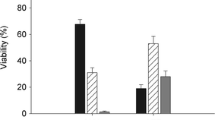Abstract
Algit Super®, an extract ofAscophyllum nodosum, was found to be an effective stimulant for the germination ofOrobanche ramosa seeds. The biological activity of Algit Super® was tested at a wide range of concentrations from 2.5 v/v to 1.2 × 10−3 v/v. The seed germination in all studiedO. ramosa populations showed a concentration dependence, with an inhibitory effect at higher concentrations. The response ofO. ramosa to Algit Super® resembled its response to the reference stimulant GR24. VariousO. ramosa populations demonstrated differential response to the stimulant.
Similar content being viewed by others
References
Aitken, J.B. and Senn, T.L. (1965) Seaweed products as a fertilizer and soil conditioner for horticultural crops.Bot. Mar. 8:144–148.
Batchvarova, R.B., Slavov, S.B. and Bossolova, S.N. (1999)In vitro culture ofOrobanche ramosa.Weed Res. 39:191–197.
Blunden, G. (1991) Agricultural uses of seaweeds and seaweed products.in: Guiry, M.D. and Blunden, G. [Eds.] Seaweed Resources in Europe: Uses and Potential. J. Wiley and Sons, Chichester, UK. pp. 65–81.
Crouch, I.J. and van Staden, J. (1993) Evidence for the presence of plant growth regulators in commercial seaweed products.Plant Growth Regul. 13:21–29.
Economou, G., Lyra, D., Kotoulas, V. and Kotoula-Syka, E. (2005) Induction of seed germination inOrobanche aegyptiaca to various seed stimulants.Proc. 13 th Symp. European Weed Research Society (Bari, Italy).
Egley, G.H. (1972) Influence of the seed envelope and growth regulators upon seed dormancy in witchweed (Striga lutea Lour.).Ann. Bot. 36:755–770.
Evans, G., Evans, J., Redman, A., Johnson, N. and Foust, R.D. (2005) Unexpected beneficial effects of arsenic on corn roots grown in culture.Environ. Chem. 2:167–170
Foy, C.L., Jain, R. and Jacobsohn, R. (1989) Recent approaches for chemical control of broomrape (Orobanche spp.).Rev. Weed Sci. 4:123–152
Francesconi, K.A. (2005) Current perspectives in arsenic environmental and biological research.Environ. Chem. 2:141–145.
Gonsior, G., Buschmann, H., Szinicz, G., Spring, O. and Sauerborn, J. (2004) Induced resistance — an innovative approach to manage branched broomrape (Orobanche ramosa) in hemp and tobacco.Weed Sci. 52:1050–1053.
Harper, S.L. (1997) Population Biology of Plants. Academic Press, London. UK.
Joel, D.M., Steffens, J.C. and Matthews, D.E. (1995) Germination of weedy root parasites.in: Kigel, J. and Galili, G. [Eds.] Seed Development and Germination. Marcel Dekker Inc., New York, NY. pp. 567–598.
Johnson, G.D., Stephen, G.H., Geronimo, J. and Wise, J.M. (2001) Orthophenylphenol and phenylhydroquinone residues in citrus fruit and processed citrus products after postharvest fungicidal treatments with sodium orthophenylphenate in California and Florida.J. Agric. Food Chem. 49:2497–2502.
Kebreab, E. and Murdoch, A.J. (2001) Simulation of integrated control strategies forOrobanche spp. based on a life cycle model.Expl. Agric. 37:37–51.
Kingman, A.R. and Moore, J. (1982) Isolation, purification and quantitation of several growth regulating substances inAscophyllum nodosum (Phaeophyta).Bot. Mar. 25:149–153.
Kingman, A.R. and Senn, T.L. (1977) Bioassay systems to test for plant growth hormones in extracts ofAscophyllum nodosum.J. Phycol. 13(Suppl.):36.
Matthews, D.E., Joel, D.M. and Steffens, J.C. (1991) Species-specific responses ofOrobanche to host-derived and synthetic germination stimulants.in: Ransom, J.K., Musselman, L.J., Worsham, D. and Parker, C. [Eds.]Proc. Fifth International Symp. on Parasitic Weeds (CIMMYT, Nairobi, Kenya), pp. 428–434.
Meier, J., Kienzl, N., Goessler, W. and Francesconi, K.A. (2005) The occurrence of thio-arsenosugars in some samples of marine algae.Environ. Chem. 2:304–307.
Motulsky, H. and Christopoulos, A. (2003) Fitting Models to Biological Data Using Linear and Non-linear Regression. A Practical Guide to Curve Fitting. GraphPad Inc., San Diego, CA, USA. pp. 293–295.
Senn, T.L. and Kingman, A.R. (1978) Seaweed Research in Crop Production: 1958–1978. Economic Development Administration, U.S. Dept. of Commerce, Washington, DC. pp. 70–71.
Vallance, K.B. (1950) Studies on the germination of the seeds ofStriga hermonthica. I. The influence of moisture-treatment, stimulant-dilution, and after-ripening on germination.Ann. Bot. 14:347–352.
Wigchert, S.C.M., Kuiper, E., Boelhouwer, G.J., Nefkens, G.H.L., Verkleij, J.A.C. and Zwanenburg, B. (1999) Dose-response of seeds of the parasitic weedsStriga andOrobanche toward the synthetic germination stimulants GR24 and Nijmegen 1.J. Agric. Food Chem. 47:1705–1710.
Wu, X.F., Jenkins, T., Blunden, G., von Mende, N. and Hankins, S.D. (1998) Suppression of fecundity of the root-knot nematode,Meloidogyne javanica, in monoxenic cultures ofArabidopsis thaliana treated with an alkaline extract ofAscophyllum nodosum.J. Appl. Phycol. 10:91–94.
Zhou, W.J., Yoneyama, K., Takeuchi, Y., Iso, S., Rungmekarat, S., Chae, S.H.et al. (2004)In vitro infection of host roots by differentiated calli of the parasitic plantOrobanche.J. Exp. Bot. 55:899–907.
Author information
Authors and Affiliations
Corresponding author
Additional information
http://www.phytoparasitica.org posting Aug. 5, 2007.
Rights and permissions
About this article
Cite this article
Economou, G., Lyra, D., Sotirakoglou, K. et al. StimulatingOrobanche ramosa seed germination with anAscophyllum nodosum extract. Phytoparasitica 35, 367–375 (2007). https://doi.org/10.1007/BF02980699
Received:
Accepted:
Issue Date:
DOI: https://doi.org/10.1007/BF02980699




